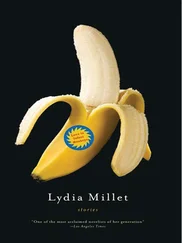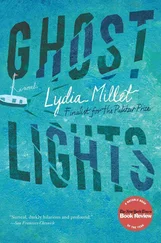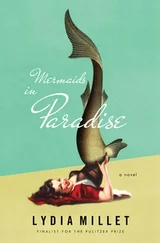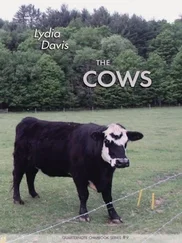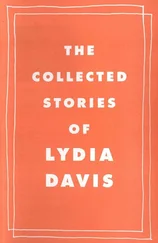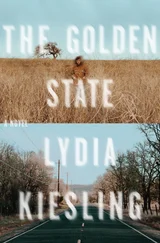Why did he have to be dead? The old man was dead just like his specimens, but not as nicely preserved and she could ask him nothing. Still she wanted to know about all of this. She wanted to know where he had gotten his bestiary. She leaned in and looked at the map again: there was a piece she thought she had missed, a large square on the corner of the footprint. It appeared to be a room she hadn’t noticed, a room that maybe wasn’t here. There was no label on it. The square was blank, with only a notch in one side for a door. She turned around, orienting herself. It should be past the dodo case, she thought, the door to the room, and checked the floor plan again to make sure. If it was here at all.
She walked back, past the glass, past the yellow-brown rib cage of the bird. What if that skeleton was fake, she thought — a movie prop from a back lot somewhere or an ostrich or something — and all of this some kind of hoax? Possible. The old man was so inscrutable. In the semidarkness she could see planks propped up against the wall, two-by-fours. She reached up and moved them aside. And there it was: a thin white door in the sheetrock, unfinished. Not even a knob yet, only a hole cut near the edge, where a future knob was meant to go. . she hooked two fingers into the hole and pulled, and the door wobbled and came off entirely. It wasn’t on hinges, even, just sitting there. She set it aside.
Black then, in front of her: a whole separate room. She took a step and fumbled inside to the left, then the right for a switch, and finally she found one. More clicking fluorescents, and she was in. She thought it was empty at first, until she noticed the walls were divided into squares — cabinets, all of them. Drawers. Square white drawers from the floors to the ceilings, like a morgue in a crime procedural, except there was no refrigeration. She assumed the drawers in morgues were refrigerated. Weren’t they? Toe tags, people’s lips blue? She’d never been to a morgue.
The drawers in this room, like the metal cabinets in the other, were unmarked on the outside. She approached the first one on her right, at eye level, with hesitation. It took her a minute, and then she pulled it open.
Bones, old-looking — maybe a chimpanzee or gorilla, something large and anthropoid, not all connected and not complete, but neatly arranged where they should be. There was only half of one leg, and the skull was far back in the drawer. She could make out a jawbone.
She didn’t want to look closely at the skull. The skull was excessive. But then — the sockets of her eyes shot with pain suddenly, her headache returning to prominence — despite herself she opened the drawer beneath: another set of similar bones.
But these had scraps of clothing on them. She saw the foot bones and the shins.
And the drawer above. Filthy, stained-looking and ancient brown bandages: the remnants of some kind of mummification process. She’d seen one long ago on exhibit, though mostly she remembered the pharaoh’s gold coffin with his headpiece of blue stripes. But this was no monarch. More reminiscent of those glassed-in scenes of Indians, old-fashioned displays from before the days of political correctness — the colonial superiority, the cruelty of patronage. Women in beaded headbands sitting and grinding corn on concave stones near a campfire, or women weaving with their papooses on their backs, a scene from a made-up history.
She looked for a label now, found she was looking, inevitably. And it was there, on the inside of the drawer’s front panel, hard to make out at first.
Haush tribeswoman. Tierra del Fuego, Argentina. Extermination, measles, smallpox. @ 1925 .
The label in the middle drawer, which held a smaller skeleton, read Chono youth, T del F, Argentina. Early 20th c. The bottom drawer, with a label printed on a dot-matrix printer, as though it was more recent: Yaghan man, “Domingo,” T del F, Argentina. Measles, other diseases, prob. introduced by missionaries. @ 1960 .
The headache came in waves — maybe the aspirin would dull it once it was all the way into her system. She sank down to the floor, her back against the closed drawers. Her knees were raised in front of her and she studied them. If she dropped her knees to the cold floor and her legs stuck out straight she would be a parallel set of bones. . it made no sense, she thought: he had his club, they had their animal trophies; his club hadn’t hunted these dead people, the members of vanished tribes. It was as though the old man had changed his angle at the end of his life, suddenly. Almost — though she would never know, she thought, self-pitying — as though he had veered from his hunting trajectory, from his celebration of killing, into this plain and sad little corner. An unfinished room of people’s bones.
The room had a melancholy spareness, the end of a long fight, a battlefield desolate with the flattened — the now so modest! — remains of the dead. Above the dry winter grasses rose the pennants of friends and enemies alike, shredded and flapping in the wind.
•
Someone was saying her name; she must have nodded off. A ghost of the old man, maybe, or one of the victims in those far-off tribes, killed with measles, killed by the passion of the emissaries of Christ.
But no: it was only Jim. He was calling down from a hole in the roof of the earth. The hole in the world. He called down to her from the sky.
She got up slowly, not without some twinges of joint ache, and went through the animal room again, aware of the spectacle of their dead beauty on both sides of her as she walked, dreamily. She followed his voice toward the brick well, surrounded by the derelict loveliness. Then the half-light of the open door was behind her. She blinked and fumbled with her flashlight.
“Susan,” he was saying, insistently. “Are you down there?”
She found the switch, felt the plastic ridges under her thumb and pushed it, raising the light shakily until it captured his legs — his legs at the edge of the opening. The bottom of his shirt. He wasn’t bending down, rather he was standing. He wore pants.
Of course he wore pants. A man often did.
She liked, come to think of it, the idea of men who didn’t wear pants — Scotland men. Scottishers, Scotch. Was that what they called them? Scots, that was it. Also men in parts of Asia, including monks, possibly. And certain Arabs. They wore djellabas, for instance. Bless them, bless them, bless all those skirt-wearing men. Truthfully, the skirts looked good on them. There was nothing feminine about a skirt. Not necessarily. If more of the men, over the course of history, had worn skirts. . but she, of course, had never been on the battlefield. She and the others of her kind were always far away — the tragedy elapsed and people like her, for much of history, remained on the sidelines. Men slew each other, they slew the animals, went slaying and slaying. Women were mostly witnesses. They were not innocent — it wasn’t that simple, not by a long shot — more like accessories to the crime, if not the principal offenders. They saw killing ravage all things beneath the sun and were the silent partner in it. You didn’t want to kill, you had no interest in killing — your very genes went against it. Possibly your hormones. Again, the molecules that governed you. But you were also far too weak to stop it. Your weakness was your crime.
Not weaker than the men, per se, just differently weak. The wanting to be liked, avoidance of conflict. . you were profoundly and eternally guilty of this terrible weakness, this moral as well as physical weakness, the fear of being hurt, of being injured, of being embarrassed. You were crippled by the guilt of being who you were. Guilty of being yourself.
The self-help books urged you to be yourself, and yet, as it turned out, being yourself was the crime to end all crimes.
Читать дальше


